
Cividade de Terroso
Encyclopedia
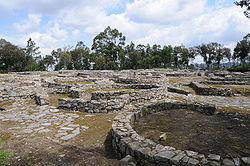
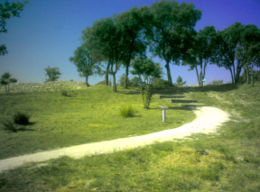
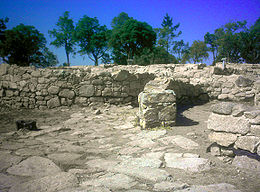
Castro culture
Castro culture is the archaeological term for naming the Celtic archaeological culture of the northwestern regions of the Iberian Peninsula from the end of the Bronze Age until it was subsumed in local Roman culture...
in North-western Iberian Peninsula
Iberian Peninsula
The Iberian Peninsula , sometimes called Iberia, is located in the extreme southwest of Europe and includes the modern-day sovereign states of Spain, Portugal and Andorra, as well as the British Overseas Territory of Gibraltar...
, located in Póvoa de Varzim
Póvoa de Varzim
Póvoa de Varzim is a Portuguese city in the Norte Region and sub-region of Greater Porto, with a 2011 estimated population of 63,364. According to the 2001 census, there were 63,470 inhabitants with 42,396 living in the city proper. The urban area expanded, southwards, to Vila do Conde, and there...
, Portugal
Portugal
Portugal , officially the Portuguese Republic is a country situated in southwestern Europe on the Iberian Peninsula. Portugal is the westernmost country of Europe, and is bordered by the Atlantic Ocean to the West and South and by Spain to the North and East. The Atlantic archipelagos of the...
.
The city, known in the Middle Ages
Middle Ages
The Middle Ages is a periodization of European history from the 5th century to the 15th century. The Middle Ages follows the fall of the Western Roman Empire in 476 and precedes the Early Modern Era. It is the middle period of a three-period division of Western history: Classic, Medieval and Modern...
as Civitas Teroso, was built at the top of Cividade Hill
Cividade Hill
thumb|200px|The hilltop. Entrance of [[Cividade de Terroso]].Cividade Hill is one of the two hills next to the city of Póvoa de Varzim in Portugal...
, in the parish
Freguesia
Freguesia is the Portuguese term for a secondary local administrative unit in Portugal and some of its former colonies, and a former secondary local administrative unit in Macau, roughly equivalent to an administrative parish. A freguesia is a subdivision of a concelho, the Portuguese synonym term...
of Terroso, in Póvoa de Varzim, less than 5 km from the coast, near the eastern edge of the modern city.
Situated in the heart of the Castro region, the Cividade prospered due to its strong defensive walls and its location near the ocean, which facilitated trade with the maritime civilization
Civilization
Civilization is a sometimes controversial term that has been used in several related ways. Primarily, the term has been used to refer to the material and instrumental side of human cultures that are complex in terms of technology, science, and division of labor. Such civilizations are generally...
s of the Mediterranean Sea
Mediterranean Sea
The Mediterranean Sea is a sea connected to the Atlantic Ocean surrounded by the Mediterranean region and almost completely enclosed by land: on the north by Anatolia and Europe, on the south by North Africa, and on the east by the Levant...
. However, this trade eventually attracted Roman
Ancient Rome
Ancient Rome was a thriving civilization that grew on the Italian Peninsula as early as the 8th century BC. Located along the Mediterranean Sea and centered on the city of Rome, it expanded to one of the largest empires in the ancient world....
attention and the Cividade and the Castro culture perished at the end of the Lusitanian War
Lusitanian War
The Lusitanian War, called the Purinos Polemos , was a war of resistance fought between the advancing legions of the Roman Republic and the Lusitani tribes of Hispania Ulterior from 155 to 139 BC. The Lusitani revolted on two separate occasions and were pacified...
, in which Rome's victory was secured through the murder of Viriathus
Viriathus
Viriathus was the most important leader of the Lusitanian people that resisted Roman expansion into the regions of Western Hispania , where the Roman province of Lusitania would be established...
, leader of the Lusitanians
Lusitanians
The Lusitanians were an Indo-European people living in the Western Iberian Peninsula long before it became the Roman province of Lusitania . They spoke the Lusitanian language which might have been Celtic. The modern Portuguese people see the Lusitanians as their ancestors...
.
Beyond the main Castro settlement, three of Cividade de Terroso's outposts are known: Castro de Laundos (mostly unexplored), Castro de Navais (only the fountain and site remains, because it is inhabited to this day), and Castro de Argivai (severely damaged).
History
The settlement of Cividade de Terroso was founded during the Bronze AgeBronze Age
The Bronze Age is a period characterized by the use of copper and its alloy bronze as the chief hard materials in the manufacture of some implements and weapons. Chronologically, it stands between the Stone Age and Iron Age...
, between 800 and 900 BC, as a result of the displacement of the resident people in the fertile plain of Beiriz and Várzea of Póvoa de Varzim. That date is supported by the discovery of egg-shaped cesspit
Cesspit
A cesspit, or cesspool is a pit, conservancy tank, or covered cistern, which can be used to dispose of urine and feces, and more generally of all sewage and refuse. It is a more antiquated solution than a sewer system. Traditionally, it was a deep cylindrical chamber dug into the earth, having...
s, excavated in 1981 by Armando Coelho, where he collected fragments of four vases of the previous period to the establishment of the settlement of the Cividade. Thus, it is part of the oldest castros, such as the Santa Luzia or Roriz castros.
The Castro maintained trade relations with the civilizations of the Mediterranean, mainly during the Carthaginian dominium in South-eastern Iberian Peninsula.
During the Punic Wars
Punic Wars
The Punic Wars were a series of three wars fought between Rome and Carthage from 264 B.C.E. to 146 B.C.E. At the time, they were probably the largest wars that had ever taken place...
, the Romans had learned of the wealth of the Castro region in gold
Gold
Gold is a chemical element with the symbol Au and an atomic number of 79. Gold is a dense, soft, shiny, malleable and ductile metal. Pure gold has a bright yellow color and luster traditionally considered attractive, which it maintains without oxidizing in air or water. Chemically, gold is a...
and tin
Tin
Tin is a chemical element with the symbol Sn and atomic number 50. It is a main group metal in group 14 of the periodic table. Tin shows chemical similarity to both neighboring group 14 elements, germanium and lead and has two possible oxidation states, +2 and the slightly more stable +4...
. Viriathus, who led the Lusitanian troops, hindered northward growth of the Roman territory at the Douro
Douro
The Douro or Duero is one of the major rivers of the Iberian Peninsula, flowing from its source near Duruelo de la Sierra in Soria Province across northern-central Spain and Portugal to its outlet at Porto...
river, but his murder in 138 BC opened the way for the Roman legion
Roman legion
A Roman legion normally indicates the basic ancient Roman army unit recruited specifically from Roman citizens. The organization of legions varied greatly over time but they were typically composed of perhaps 5,000 soldiers, divided into maniples and later into "cohorts"...
s.
Decimus Junius Brutus
Decimus Junius Brutus Callaicus
Decimus Junius Brutus Callaicus was a Roman politician and general of the 2nd century BC. He was the son of the consul Marcus Junius Brutus and brother of the praetor Marcus Junius Brutus; he himself was appointed consul in 138 BC...
led a campaign in order to annex the Castro region, which lead to the complete destruction of the Cividade, just after the death of Viriathus. The deeds of the Roman commander had echoed in Rome
Rome
Rome is the capital of Italy and the country's largest and most populated city and comune, with over 2.7 million residents in . The city is located in the central-western portion of the Italian Peninsula, on the Tiber River within the Lazio region of Italy.Rome's history spans two and a half...
, where he passed to be known by the title Callaicus - from Gallaecia, name by which the Romans knew the Castro region, in honour of the people that settled in the area of Calle - the Callaeci, later the Roman Portus Calle, today's Porto
Porto
Porto , also known as Oporto in English, is the second largest city in Portugal and one of the major urban areas in the Iberian Peninsula. Its administrative limits include a population of 237,559 inhabitants distributed within 15 civil parishes...
.

The region was incorporated in the Roman Empire and totally pacified during the rule of Caesar Augustus. In the coastal plain, a Roman villa was created, property of a Roman family known as the Euracini. The family was joined by Castro people that started to return to the life in the plain, and Villa Euracini was built. The fishery activity developed with the cetariæ, a Roman method of preserving fish in brine. Thus, from the 1st century onwards, and during the imperial period, the gradual abandonment of Cividade Hill started.
In Memória Paroquiais (Parish Memories) of 1758, the director António Fernandes da Loba with other clergymen from the parish of Terroso, wrote: This parish is all surrounded by farming fields, and by just one part, almost in the middle of it, there is a more elevated hill, that is about a third of the farming fields of the given parish and the Ancient say that this was the City of Moors Hill, because it is known as Cividade Hill.
The Lieutenant Veiga Leal in the News of Póvoa de Varzim on May 24 of 1758 writes: "The Hill known as Cividade, where one can see several hints of houses, that people say they formed a city, to this town came cars with bricks from the ruins of that one."
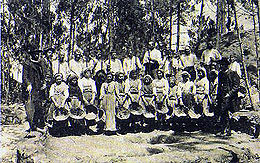
Archaeology
Archaeology, or archeology , is the study of human society, primarily through the recovery and analysis of the material culture and environmental data that they have left behind, which includes artifacts, architecture, biofacts and cultural landscapes...
in the Cividade.
Excavations began on June 5 of the year 1906 with 25 manual workers and continued until October of the same year, interrupted due to bad weather; they recommenced in May 1907, finishing that same year. The materials discovered were taken to museum
Museum
A museum is an institution that cares for a collection of artifacts and other objects of scientific, artistic, cultural, or historical importance and makes them available for public viewing through exhibits that may be permanent or temporary. Most large museums are located in major cities...
s in the city of Porto
Porto
Porto , also known as Oporto in English, is the second largest city in Portugal and one of the major urban areas in the Iberian Peninsula. Its administrative limits include a population of 237,559 inhabitants distributed within 15 civil parishes...
.
After the death of Rocha Peixoto, in 1909, some rocks of the Cividade had been used to pave some streets of the Póvoa de Varzim, explicitly Rua Santos Minho Street and Rua das Hortas. Occasionally, groups of scouts of the Portuguese Youth and others in the decades of 1950 and 1960, made diggings in search for archaeology pieces. This was seen as archaeological vandalism, but continued even after the Cividade was listed as a property of Public Interest in 1961.
In 1980, the City council of the Póvoa de Varzim invited Armando Coelho to pursue further archaeological works; these took place during the summer of that year. Later, the city acquired the acropolis
Acropolis
Acropolis means "high city" in Greek, literally city on the extremity and is usually translated into English as Citadel . For purposes of defense, early people naturally chose elevated ground to build a new settlement, frequently a hill with precipitous sides...
area and constructed the archaeological museum of the Cividade de Terroso in its entrance.
In 2005, groups of Portuguese
Portugal
Portugal , officially the Portuguese Republic is a country situated in southwestern Europe on the Iberian Peninsula. Portugal is the westernmost country of Europe, and is bordered by the Atlantic Ocean to the West and South and by Spain to the North and East. The Atlantic archipelagos of the...
and Spanish
Spain
Spain , officially the Kingdom of Spain languages]] under the European Charter for Regional or Minority Languages. In each of these, Spain's official name is as follows:;;;;;;), is a country and member state of the European Union located in southwestern Europe on the Iberian Peninsula...
(Galician) archaeologists had started to study the hypothesis of this cividade and six others to be classified as World Heritage sites of UNESCO
UNESCO
The United Nations Educational, Scientific and Cultural Organization is a specialized agency of the United Nations...
. The visit of UNESCO's inspectors is foreseen for 2007.
Defensive system
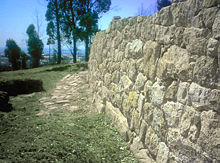
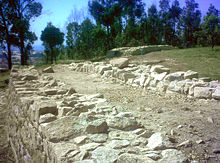
The movements of Turduli
Turduli
The Turduli were an ancient Celtiberian tribe of Lusitania, akin to the Lusitanians. They lived in the south of modern Portugal, in the east of the province of Alentejo, along the Guadiana valley , and Extremadura proper...
and Celtici
Celtici
]The Celtici were a Celtic tribe or group of tribes of the Iberian peninsula, inhabiting three definite areas: in what today are the provinces of Alentejo and the Algarve in Portugal; in the Province of Badajoz and north of Province of Huelva in Spain, in the ancient Baeturia; and along the...
proceeding from the South of the Iberian Peninsula in direction to the North are referred by Strabo
Strabo
Strabo, also written Strabon was a Greek historian, geographer and philosopher.-Life:Strabo was born to an affluent family from Amaseia in Pontus , a city which he said was situated the approximate equivalent of 75 km from the Black Sea...
and have motivated the improvement of the defensive systems of the castros around 500 BC.
Cividade de Terroso is one of the most heavily defended castros, given that the acropolis was surrounded by three rings of walls. These walls were built at different stages, due to the growth of the town.
The walls were composed of great blocks without mortar
Mortar (masonry)
Mortar is a workable paste used to bind construction blocks together and fill the gaps between them. The blocks may be stone, brick, cinder blocks, etc. Mortar becomes hard when it sets, resulting in a rigid aggregate structure. Modern mortars are typically made from a mixture of sand, a binder...
and were adapted to the topography of the mount. The areas of easier access (South, East and West) possessed high, wide and resistant walls; while the ones in land with steep slopes were protected mainly by strengthening the local features.
That can easily be visible with the discovered structures in the East that present a strong defensive system that reaches 5.30 metres (17 feet 5 inches) wide. While in the Northeast, the wall was constructed using natural granite
Granite
Granite is a common and widely occurring type of intrusive, felsic, igneous rock. Granite usually has a medium- to coarse-grained texture. Occasionally some individual crystals are larger than the groundmass, in which case the texture is known as porphyritic. A granitic rock with a porphyritic...
that only was crowned by a wall of rocks.
The entrance that interrupted the wall was paved with flagstone with about 1.70 metres (5 feet 7 inches) of width. The defensive perimeter seems to have been complemented with a ditch of about 1 metre (3 feet 3 inches) of depth and width in base of the mount, as it was detected while a house was being built in the north of the mount.
Urban structure

In the archaeological works carried through the beginning of 20th century, the Cividade seemed to have a disorganized structure, but more recent data suggests instead an organization whose characteristics stem from older levels of occupation, which had been ignored during the first archaeological works.
Each one of the quadrants of the Cividade is divided in nuclei around a family square almost always paved with flagstone. Some houses possessed a forecourt
Forecourt
In architecture a forecourt is an open area in front of a structure's entrance.In archaeology, forecourt is the name given to the area in front of certain types of chamber tomb...
.
At its peak, the Cividade would enclose nearly 12 hectares (30 acres) and was inhabited by several hundred people.
Stages
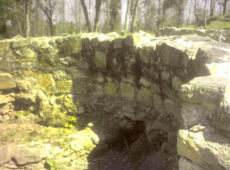
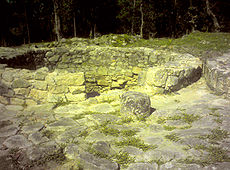
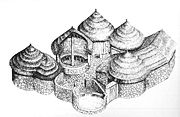
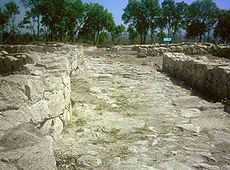
Adobe
Adobe is a natural building material made from sand, clay, water, and some kind of fibrous or organic material , which the builders shape into bricks using frames and dry in the sun. Adobe buildings are similar to cob and mudbrick buildings. Adobe structures are extremely durable, and account for...
.
The first constructions in rock started to take form in the 5th century B.C., supplies that became to be used due to technological progress with the production of iron peaks, a technology that was only available in Asia Minor
Asia Minor
Asia Minor is a geographical location at the westernmost protrusion of Asia, also called Anatolia, and corresponds to the western two thirds of the Asian part of Turkey...
, but that was brought to the Iberian Peninsula by Phoenician settlers in the Atlantic Coast during the 8th and 7th centuries B.C.
The constructions of this time are, characteristically, circular with diameters between 4 and 5 meters and with walls 30 to 40 cm thick. The granite rocks were fractured or splintered, later to be located in two lines, with the smoothest part for the exterior and interior of the house. The space between the two rocks was filled with small rocks and mortar of gross sand giving a robust structure to the walls.
In the last stage of the Cividade, the Roman stage (starting in 138–136 B.C.), following the destruction by Decimus Junius Brutus, there is an urban reorganization with use of the new constructive techniques and alteration of forms and dimensions; mostly with the appearance of quadrangular structures, in substitution of circular typically of the Castro culture. The coverings start to use "tegula
Imbrex and tegula
The imbrex and tegula were overlapping roof tiles used in ancient Greek and Roman architecture as a waterproof and durable roof covering. They were made predominantly of fired clay, but also sometimes of marble, bronze or gilt...
" instead of vegetal material with adobe.
During this stage, the used rocks for the construction of the habitations were quadrangular; the project of two lines remained, but the interior space was wider and filled with gross sand or adobe and rocks of small or average size, resulting in thicker walls with 45–60 cm.
Family settings
The family settings, composed by four or five circular divisions, encircle a paved yard with flagstone to where the doors of the different divisions converged. These central yards had important role in family life and were where the daily family activities would take place. These nuclei would be closed by key, disclosing the concern for privacy by families.The interior of the constructions of the second stage, previous to the Roman, possessed fine floors made of adobe or gross sand. Some of these floors were decorated with the impression of ropes, wave drawings and impression of circles, especially in fireplaces. In the Roman-influence stage, these floors had become well-taken care of, being denser and thicker.
Streets
The family settings were divided by narrow roads with some public spaces. The two main streets had the typical Roman orientation of the Decumanus and Cardium. The Decumanus was a street that slightly followed the wall to the East for the West and slightly curved for Southwest from the crossroad with the Cardium (North-South street), finishing in the entrance of the Cividade. The exterior access was fulfilled by a delicate descending until the way that is still used today to enter in the Cividade.These main roads divided the settlement in four parts. Each one of these parts was composed of four to five family settings.
In some points of the city, vestiges of sewers or narrow channels had been discovered; these would serve to direct rain water.
Culture
The population was devoted to agriculture of cereals and vegetables, fishery, recollection, shepherdShepherd
A shepherd is a person who tends, feeds or guards flocks of sheep.- Origins :Shepherding is one of the oldest occupations, beginning some 6,000 years ago in Asia Minor. Sheep were kept for their milk, meat and especially their wool...
ing and worked metal
Metal
A metal , is an element, compound, or alloy that is a good conductor of both electricity and heat. Metals are usually malleable and shiny, that is they reflect most of incident light...
s, textile
Textile
A textile or cloth is a flexible woven material consisting of a network of natural or artificial fibres often referred to as thread or yarn. Yarn is produced by spinning raw fibres of wool, flax, cotton, or other material to produce long strands...
s and ceramic
Ceramic
A ceramic is an inorganic, nonmetallic solid prepared by the action of heat and subsequent cooling. Ceramic materials may have a crystalline or partly crystalline structure, or may be amorphous...
s. From the interior of the Iberian Peninsula cultural influences had arrived, beyond the ones proceeding from the Mediterranean through commerce.
The Castro culture is known by having defensive walls in their cities and villages, with circular houses in mount tops and for its characteristic ceramics, widely popular among them, and it dies with the Roman acculturation and the movement of the populations for the coastal plain, where the strong Roman cultural presence, from the 2nd century BC onwards, is visible in the vestiges of Roman villas found there where, currently, the city of the Póvoa de Varzim is located (Old Town of Póvoa de Varzim, Alto de Martim Vaz and Junqueira), andin the parishes of Estela (Vila Mendo) and near the Chapel of Santo André in Aver-o-Mar.
Feeding
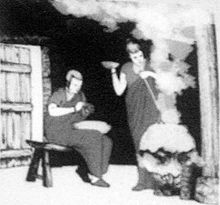
Cereal
Cereals are grasses cultivated for the edible components of their grain , composed of the endosperm, germ, and bran...
s such as wheat
Wheat
Wheat is a cereal grain, originally from the Levant region of the Near East, but now cultivated worldwide. In 2007 world production of wheat was 607 million tons, making it the third most-produced cereal after maize and rice...
and barley
Barley
Barley is a major cereal grain, a member of the grass family. It serves as a major animal fodder, as a base malt for beer and certain distilled beverages, and as a component of various health foods...
, and of vegetable
Vegetable
The noun vegetable usually means an edible plant or part of a plant other than a sweet fruit or seed. This typically means the leaf, stem, or root of a plant....
s (the broadbean
Broadbean
-Plant:* Broad Bean or Vicia faba , a species of bean native to north Africa and southwest Asia-Company:* Broadbean, Inc., a London, England-based software company...
) and acorn
Acorn
The acorn, or oak nut, is the nut of the oaks and their close relatives . It usually contains a single seed , enclosed in a tough, leathery shell, and borne in a cup-shaped cupule. Acorns vary from 1–6 cm long and 0.8–4 cm broad...
.
The concheiro found in the Cividade showed that they ate limpet
Limpet
Limpet is a common name for a number of different kinds of saltwater and freshwater snails ; it is applied to those snails that have a simple shell which is more or less conical in shape, and either is not spirally coiled, or appears not to be coiled in the adult snails.The name limpet is most...
s, mussel
Mussel
The common name mussel is used for members of several families of clams or bivalvia mollusca, from saltwater and freshwater habitats. These groups have in common a shell whose outline is elongated and asymmetrical compared with other edible clams, which are often more or less rounded or oval.The...
s and Sea urchin
Sea urchin
Sea urchins or urchins are small, spiny, globular animals which, with their close kin, such as sand dollars, constitute the class Echinoidea of the echinoderm phylum. They inhabit all oceans. Their shell, or "test", is round and spiny, typically from across. Common colors include black and dull...
s in raw or cooked form. These species are still broadly common. Fishing must not have been a regular activity, given the lack of archaeological evidence, but the discovery of hooks and net weights demonstrates that the Castro people were able to catch fish of considerable size such as grouper
Grouper
Groupers are fish of any of a number of genera in the subfamily Epinephelinae of the family Serranidae, in the order Perciformes.Not all serranids are called groupers; the family also includes the sea basses. The common name grouper is usually given to fish in one of two large genera: Epinephelus...
and snook
Snook
Snook or Snoek may refer to:* Fish in the family** Centropomidae especially the common snook.** Gempylidae ** Percidae ** Scombridae , subfamily: Scombrinae** Sphyraenidae...
.
Barley was cultivated to produce a kind of beer
Beer
Beer is the world's most widely consumed andprobably oldest alcoholic beverage; it is the third most popular drink overall, after water and tea. It is produced by the brewing and fermentation of sugars, mainly derived from malted cereal grains, most commonly malted barley and malted wheat...
, which was nicknamed zythos. Beer was considered a barbaric drink by the Greeks and Romans given the fact that they were accustomed to the subtleness of wine
Wine
Wine is an alcoholic beverage, made of fermented fruit juice, usually from grapes. The natural chemical balance of grapes lets them ferment without the addition of sugars, acids, enzymes, or other nutrients. Grape wine is produced by fermenting crushed grapes using various types of yeast. Yeast...
. Acorn was triturated to create a kind of flour
Flour
Flour is a powder which is made by grinding cereal grains, other seeds or roots . It is the main ingredient of bread, which is a staple food for many cultures, making the availability of adequate supplies of flour a major economic and political issue at various times throughout history...
.
Collection of wild plants, fruits, seeds and roots was used to complement dietary staples; eating and collecting wild blackberries
Blackberry
The blackberry is an edible fruit produced by any of several species in the Rubus genus of the Rosaceae family. The fruit is not a true berry; botanically it is termed an aggregate fruit, composed of small drupelets. The plants typically have biennial canes and perennial roots. Blackberries and...
, dandelion, clover
Clover
Clover , or trefoil, is a genus of about 300 species of plants in the leguminous pea family Fabaceae. The genus has a cosmopolitan distribution; the highest diversity is found in the temperate Northern Hemisphere, but many species also occur in South America and Africa, including at high altitudes...
s and even kelp
Kelp
Kelps are large seaweeds belonging to the brown algae in the order Laminariales. There are about 30 different genera....
s. Some of these vegetables are still used by the local population today. The Romans introduced the consumption of wine and olive oil
Olive oil
Olive oil is an oil obtained from the olive , a traditional tree crop of the Mediterranean Basin. It is commonly used in cooking, cosmetics, pharmaceuticals, and soaps and as a fuel for traditional oil lamps...
.
The animals used by the Castro people are confirmed by classic documents and archaeological registers, and included horse
Horse
The horse is one of two extant subspecies of Equus ferus, or the wild horse. It is a single-hooved mammal belonging to the taxonomic family Equidae. The horse has evolved over the past 45 to 55 million years from a small multi-toed creature into the large, single-toed animal of today...
s, pig
Pig
A pig is any of the animals in the genus Sus, within the Suidae family of even-toed ungulates. Pigs include the domestic pig, its ancestor the wild boar, and several other wild relatives...
s, cows and sheep. It is interesting to note that there was a cultural taboo against the eating of horses or dogs.
There is little evidence of poultry raising during the Castro period, but during the period of Roman influence it became quite common.
Although there is only fragmentary evidence in the Cividade, hunting must have been a part of everyday life given that classic sources, such as Strabo and Pliny the Elder
Pliny the Elder
Gaius Plinius Secundus , better known as Pliny the Elder, was a Roman author, naturalist, and natural philosopher, as well as naval and army commander of the early Roman Empire, and personal friend of the emperor Vespasian...
describe the region as very rich in fauna, including: wild bear
Bear
Bears are mammals of the family Ursidae. Bears are classified as caniforms, or doglike carnivorans, with the pinnipeds being their closest living relatives. Although there are only eight living species of bear, they are widespread, appearing in a wide variety of habitats throughout the Northern...
, deer
Deer
Deer are the ruminant mammals forming the family Cervidae. Species in the Cervidae family include white-tailed deer, elk, moose, red deer, reindeer, fallow deer, roe deer and chital. Male deer of all species and female reindeer grow and shed new antlers each year...
, wild boar
Boar
Wild boar, also wild pig, is a species of the pig genus Sus, part of the biological family Suidae. The species includes many subspecies. It is the wild ancestor of the domestic pig, an animal with which it freely hybridises...
s, fox
Fox
Fox is a common name for many species of omnivorous mammals belonging to the Canidae family. Foxes are small to medium-sized canids , characterized by possessing a long narrow snout, and a bushy tail .Members of about 37 species are referred to as foxes, of which only 12 species actually belong to...
es, beaver
Beaver
The beaver is a primarily nocturnal, large, semi-aquatic rodent. Castor includes two extant species, North American Beaver and Eurasian Beaver . Beavers are known for building dams, canals, and lodges . They are the second-largest rodent in the world...
s, rabbit
Rabbit
Rabbits are small mammals in the family Leporidae of the order Lagomorpha, found in several parts of the world...
s, hare
Hare
Hares and jackrabbits are leporids belonging to the genus Lepus. Hares less than one year old are called leverets. Four species commonly known as types of hare are classified outside of Lepus: the hispid hare , and three species known as red rock hares .Hares are very fast-moving...
s and a variety of birds; all of which would have been valuable food sources.
Handicrafts

Ceramics found in the Cividade de Terroso had, many of them, local identity. Pottery was seen as a masculine work and had been found in great number and great variety, showing that it was a cheap, important and accessible produtct.
However, Cividade's ceramic structure are practically identical to the ones found in other castros of the same period. The decoration of the vases was of the incisive type, even so scapulae and impressed vases also existed; adobe lace, in rope form, with or without incisions are also found.
Drawings in "S", assigned as palmípedes, are frequently found in engraved vases, these could be printed with other printed or engraved drawings. Other decorative forms, that can appear mixed and with diverse techniques, include circles, triangles, semicircles, lines, in zig-zag, in a total of about two hundred of different kinds of drawings.
Weaving was sufficiently generalized and was seen as a feminine obligation and was also progressing, in special during the Roman period, having been found some weights of sewing press and sets of ten of cossoiros. The discovery of shears came to strengthen the idea of the systematic breeding of sheep to use their wool.
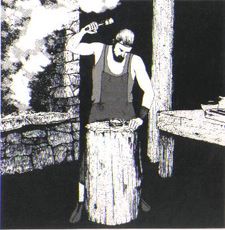
Scythe
A scythe is an agricultural hand tool for mowing grass, or reaping crops. It was largely replaced by horse-drawn and then tractor machinery, but is still used in some areas of Europe and Asia. The Grim Reaper is often depicted carrying or wielding a scythe...
or dagger
Dagger
A dagger is a fighting knife with a sharp point designed or capable of being used as a thrusting or stabbing weapon. The design dates to human prehistory, and daggers have been used throughout human experience to the modern day in close combat confrontations...
.
Near the door of the wall (in the southwest of the city) a workshop was identified, given that in the place some vestiges of this activity had been found such as the use of fire with high temperatures, nugget and slags of casting of some metals, ores and other indications.
Goldsmithery contributed for Póvoa de Varzim being one of the places of reference for proto-historical archaeology in North-western Iberian Peninsula. Namely, with the finding of some complete jewels: the Earring
Earring
Common locations for piercings, other than the earlobe, include the rook, tragus, and across the helix . The simple term "ear piercing" usually refers to an earlobe piercing, whereas piercings in the upper part of the external ear are often referred to as "cartilage piercings"...
s of Laundos and the articulated necklace
Necklace
A necklace is an article of jewellery which is worn around the neck. Necklaces are frequently formed from a metal jewellery chain. Others are woven or manufactured from cloth using string or twine....
and earrings of Estela. In the proper Cividade, some certifications of works in gold and silver had been collected by Rocha Peixoto. In all the mountain range of Rates, the ancient mining explorations are visible: Castro and Roman ones, given that these mounts possessed essential gold and silver for jewel production.
In 1904, a mason while constructing a mill in the top of the Mount of São Félix, close to the smaller Castro de Laundos, finds a vase with jewels inside, these jewels had been bought by Rocha Peixoto that took them for the Museum of Porto. The jewels had disclosed the use of an evolved technique, very similar to ones made in the Mediterranean, namely with the use of plates and welds, filigree
Filigree
Filigree is a delicate kind of jewellery metalwork made with twisted threads usually of gold and silver or stitching of the same curving motifs. It often suggests lace, and in recent centuries remains popular in Indian and other Asian metalwork, and French from 1660 to the late 19th century...
and granulated.
Religion and death rituals
The Castro people had a great number of deities. Religious cults and ceremonies had the objective to harmonize the people with natural forces.Some cesspits, for instance organized as a pentagon
Pentagon
In geometry, a pentagon is any five-sided polygon. A pentagon may be simple or self-intersecting. The sum of the internal angles in a simple pentagon is 540°. A pentagram is an example of a self-intersecting pentagon.- Regular pentagons :In a regular pentagon, all sides are equal in length and...
, adorn the flagstone of the Cividade, their function is unknown, but they may have had some magical-religious function.
The funerary ritual of the Cividade was probably common to other pre-Roman peoples of the Portuguese territory, but archaeological data are very rarely found in the Castro area, excepting for Cividade de Terroso.
The ritual of the Cividade consisted of the rite of the incineration, depositing the ashes of their dead in small circular-shaped cesspits with stonework adornment in the interior of the houses. Later, the ashes had passed to be deposited in the exterior of the houses, but inside of the family setting.
In 1980, the discovery of a funerary cist, and an entire vase, and fragments of another one without covering, evidences breaking. This vase was very similar to another found in Mount São Félix, this last one with jewels in its interior, assuming that these jewels had the same funerary context.
Commerce
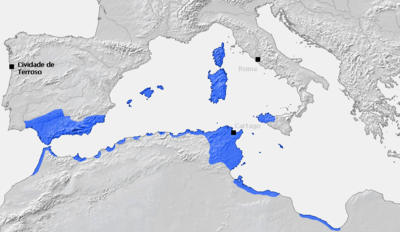
Phoenicia
Phoenicia , was an ancient civilization in Canaan which covered most of the western, coastal part of the Fertile Crescent. Several major Phoenician cities were built on the coastline of the Mediterranean. It was an enterprising maritime trading culture that spread across the Mediterranean from 1550...
ns, Carthaginians, Greeks
Ancient Greece
Ancient Greece is a civilization belonging to a period of Greek history that lasted from the Archaic period of the 8th to 6th centuries BC to the end of antiquity. Immediately following this period was the beginning of the Early Middle Ages and the Byzantine era. Included in Ancient Greece is the...
, and Romans had as objective the exchange of fabrics and wine for gold and tin, despite the scarcity of terrestrial ways, this was not a problem for Cividade de Terroso that was strategically located close to the sea and the Ave River, thus an extensive commerce existed by Atlantic and fluvial ways. However, a terrestrial one was known, the Silver Way (name on the Roman Era) that started in the south of the peninsula reaching the northeast by inland.
The external commerce, dominated by tin, was complemented with domestic commerce in tribal markets between the different cities and villages of the Castro culture, they exchanged textiles, metals (gold, copper, tin and lead) and other objects including exotic products, such as glass or exotic ceramics, proceeding from contacts with the peoples of the Mediterranean or other areas of the Peninsula.
With the annexation of the Castro region by the Roman Republic, the commerce starts to be one of the main ways for regional economic development, with the Roman merchants organized in associations known as collegia. These associations functioned as true commercial companies who looked for monopoly in commercial relations.
External links
- Subtus Montis Terroso - exhibition in the Municipal Museum of Póvoa de Varzim (July 2006 - May 2007)
- João Aguiar - Uma Deusa na Bruma, Edições Asa - Historical novel about the Cividade de Terroso (Póvoa de Varzim)

